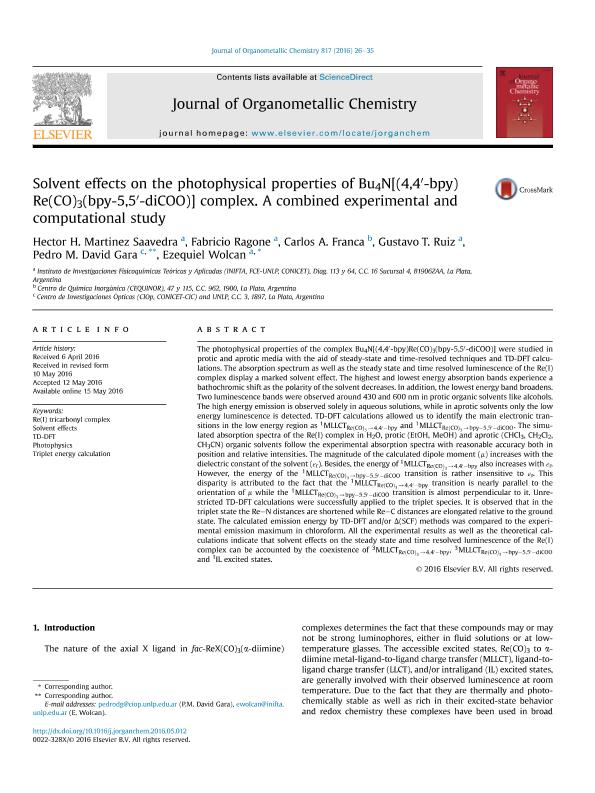Mostrar el registro sencillo del ítem
dc.contributor.author
Martínez Saavedra, Héctor Hernando

dc.contributor.author
Ragone, Fabricio

dc.contributor.author
Franca, Carlos Alberto

dc.contributor.author
Ruiz, Gustavo Teodosio

dc.contributor.author
David Gara, Pedro Maximiliano

dc.contributor.author
Wolcan, Ezequiel

dc.date.available
2018-08-06T20:04:30Z
dc.date.issued
2016-08
dc.identifier.citation
Martínez Saavedra, Héctor Hernando; Ragone, Fabricio; Franca, Carlos Alberto; Ruiz, Gustavo Teodosio; David Gara, Pedro Maximiliano; et al.; Solvent effects on the photophysical properties of Bu4N[(4,4′-bpy)Re(CO)3(bpy-5,5′-diCOO)] complex. A combined experimental and computational study; Elsevier Science Sa; Journal of Organometallic Chemistry; 817; 8-2016; 26-35
dc.identifier.issn
0022-328X
dc.identifier.uri
http://hdl.handle.net/11336/54334
dc.description.abstract
The photophysical properties of the complex Bu4N[(4,4′-bpy)Re(CO)3(bpy-5,5′-diCOO)] were studied in protic and aprotic media with the aid of steady-state and time-resolved techniques and TD-DFT calculations. The absorption spectrum as well as the steady state and time resolved luminescence of the Re(I) complex display a marked solvent effect. The highest and lowest energy absorption bands experience a bathochromic shift as the polarity of the solvent decreases. In addition, the lowest energy band broadens. Two luminescence bands were observed around 430 and 600 nm in protic organic solvents like alcohols. The high energy emission is observed solely in aqueous solutions, while in aprotic solvents only the low energy luminescence is detected. TD-DFT calculations allowed us to identify the main electronic transitions in the low energy region as 1MLLCTRe(CO)3 → 4,4′-bpy and 1MLLCTRe(CO)3 →bpy-5,5′-diCOO. The simulated absorption spectra of the Re(I) complex in H2O, protic (EtOH, MeOH) and aprotic (CHCl3, CH2Cl2, CH3CN) organic solvents follow the experimental absorption spectra with reasonable accuracy both in position and relative intensities. The magnitude of the calculated dipole moment (μ) increases with the dielectric constant of the solvent (ϵr). Besides, the energy of 1MLLCTRe(CO)3→4,4′-bpy also increases with ϵr. However, the energy of the 1MLLCTRe(CO)3 →bpy-5,5′-diCOO transition is rather insensitive to ϵr. This disparity is attributed to the fact that the 1MLLCTRe(CO)3 →4,4′-bpy transition is nearly parallel to the orientation of μ while the 1MLLCTRe(CO)3→bpy-5,5′-diCOO transition is almost perpendicular to it. Unrestricted TD-DFT calculations were successfully applied to the triplet species. It is observed that in the triplet state the Re-N distances are shortened while Re-C distances are elongated relative to the ground state. The calculated emission energy by TD-DFT and/or Δ(SCF) methods was compared to the experimental emission maximum in chloroform. All the experimental results as well as the theoretical calculations indicate that solvent effects on the steady state and time resolved luminescence of the Re(I) complex can be accounted by the coexistence of 3MLLCTRe(CO)3→4,4′-bpy, 3MLLCTRe(CO)3→bpy-5,5′-diCOO and 1IL excited states.
dc.format
application/pdf
dc.language.iso
eng
dc.publisher
Elsevier Science Sa

dc.rights
info:eu-repo/semantics/openAccess
dc.rights.uri
https://creativecommons.org/licenses/by-nc-sa/2.5/ar/
dc.subject
Photophysics
dc.subject
Re(I) Tricarbonyl Complex
dc.subject
Solvent Effects
dc.subject
Td-Dft
dc.subject
Triplet Energy Calculation
dc.subject.classification
Otras Ciencias Químicas

dc.subject.classification
Ciencias Químicas

dc.subject.classification
CIENCIAS NATURALES Y EXACTAS

dc.title
Solvent effects on the photophysical properties of Bu4N[(4,4′-bpy)Re(CO)3(bpy-5,5′-diCOO)] complex. A combined experimental and computational study
dc.type
info:eu-repo/semantics/article
dc.type
info:ar-repo/semantics/artículo
dc.type
info:eu-repo/semantics/publishedVersion
dc.date.updated
2018-08-06T18:04:19Z
dc.journal.volume
817
dc.journal.pagination
26-35
dc.journal.pais
Países Bajos

dc.journal.ciudad
Amsterdam
dc.description.fil
Fil: Martínez Saavedra, Héctor Hernando. Consejo Nacional de Investigaciones Científicas y Técnicas. Centro Científico Tecnológico Conicet - La Plata. Instituto de Investigaciones Fisicoquímicas Teóricas y Aplicadas. Universidad Nacional de La Plata. Facultad de Ciencias Exactas. Instituto de Investigaciones Fisicoquímicas Teóricas y Aplicadas; Argentina
dc.description.fil
Fil: Ragone, Fabricio. Consejo Nacional de Investigaciones Científicas y Técnicas. Centro Científico Tecnológico Conicet - La Plata. Instituto de Investigaciones Fisicoquímicas Teóricas y Aplicadas. Universidad Nacional de La Plata. Facultad de Ciencias Exactas. Instituto de Investigaciones Fisicoquímicas Teóricas y Aplicadas; Argentina
dc.description.fil
Fil: Franca, Carlos Alberto. Consejo Nacional de Investigaciones Científicas y Técnicas. Centro Científico Tecnológico Conicet - La Plata. Centro de Química Inorgánica "Dr. Pedro J. Aymonino". Universidad Nacional de La Plata. Facultad de Ciencias Exactas. Centro de Química Inorgánica "Dr. Pedro J. Aymonino"; Argentina
dc.description.fil
Fil: Ruiz, Gustavo Teodosio. Consejo Nacional de Investigaciones Científicas y Técnicas. Centro Científico Tecnológico Conicet - La Plata. Instituto de Investigaciones Fisicoquímicas Teóricas y Aplicadas. Universidad Nacional de La Plata. Facultad de Ciencias Exactas. Instituto de Investigaciones Fisicoquímicas Teóricas y Aplicadas; Argentina
dc.description.fil
Fil: David Gara, Pedro Maximiliano. Consejo Nacional de Investigaciones Científicas y Técnicas. Centro Científico Tecnológico Conicet - La Plata. Centro de Investigaciones Ópticas. Provincia de Buenos Aires. Gobernación. Comisión de Investigaciones Científicas. Centro de Investigaciones Ópticas. Universidad Nacional de La Plata. Centro de Investigaciones Ópticas; Argentina
dc.description.fil
Fil: Wolcan, Ezequiel. Consejo Nacional de Investigaciones Científicas y Técnicas. Centro Científico Tecnológico Conicet - La Plata. Instituto de Investigaciones Fisicoquímicas Teóricas y Aplicadas. Universidad Nacional de La Plata. Facultad de Ciencias Exactas. Instituto de Investigaciones Fisicoquímicas Teóricas y Aplicadas; Argentina
dc.journal.title
Journal of Organometallic Chemistry

dc.relation.alternativeid
info:eu-repo/semantics/altIdentifier/doi/https://dx.doi.org/10.1016/j.jorganchem.2016.05.012
dc.relation.alternativeid
info:eu-repo/semantics/altIdentifier/url/https://www.sciencedirect.com/science/article/pii/S0022328X16302078
Archivos asociados
